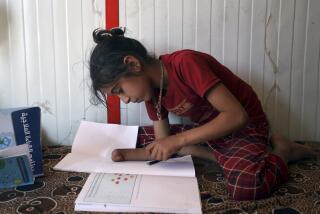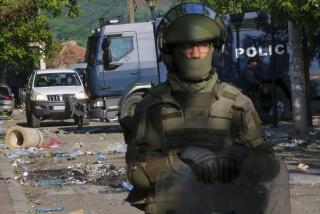NATO Bombs Kill 17 More Civilians
- Share via
SAVINE VODE, Yugoslavia — The war must have seemed so far away when Nada Matanovic boarded the bus Monday that would bring her high into the mountains, and beneath NATO’s bombs.
A girl of 15, Nada got on the express bus in the western Kosovo city of Pec with her mother so they could go to Montenegro, Serbia’s sister republic in Yugoslavia, to meet with the young man who had asked for the teenager’s hand in marriage.
She wanted her mother’s approval so that she would not bring shame on her family in the farming village of Babajloc.
Around 11:40 Monday morning, just as the highway coach slowly rounded a hairpin turn and stopped at a police checkpoint in the snowy peaks about 12 miles north of Pec, NATO bombs fell, killing an estimated 17 civilians.
Jagged chunks of shrapnel were sprayed into a white trailer that served as the police post, and at least four police officers and two soldiers were among the dead.
Like most governments in wartime, Yugoslavia’s does not release the official death toll for soldiers, preferring to keep NATO guessing about how much damage it is inflicting on armed combatants.
NATO officials said they had no information on the airstrike. Two days earlier, a NATO bomb killed 39 bus passengers as the vehicle crossed a bridge about 1 p.m., heading south on the main road to Pristina, the capital of Kosovo, a province of Serbia. NATO said it was targeting a key military supply route, and that the bus crossed the bridge after the weapon was dropped.
Even though Serbian forces, and in some cases the fear of NATO bombs, have driven hundreds of thousands of ethnic Albanians from their homes and into refugee camps, Kosovo is not deserted yet.
Hundreds of thousands of civilians, many of them ethnic Albanians, still live here. As NATO intensifies attacks on roads and bridges, many are left to wonder whether Kosovo has become a free-fire zone.
Nada was among 43 civilians who survived Monday’s bombing. In the room of 10 women and children where she lay in Pec’s main hospital, one of the wounded was a blond girl about 4 years old.
The wedding Nada and her mother had set out to plan must have seemed so far away.
A piece of shrapnel had severed Nada’s spine like a knife, and the director of Pec’s hospital, Dr. Miodrag Jasovic, judged the girl’s chances of walking again at zero.
“We were stopped at the police checkpoint, and suddenly, out of nowhere, they started bombing us,” Nada’s mother, Julka, said at the hospital. “The bus was crowded with people, and after the first explosion, we all tried to hide on the floor.
“Someone started screaming: ‘Get out! Get out of the bus! They’re bombing!’ ”
The thought of being attacked by NATO while riding a bus was so remote to passenger Sladjana Prascevic, 25, of Decani that she first thought it was an ambush by the guerrilla Kosovo Liberation Army.
One of the bombs fell about 100 yards from the road, to the left of the bus. From the wreckage in the grass, it appeared to be a direct hit on an artillery gun.
A second bomb left a crater about 10 yards deep and 12 yards across, which was about 80 yards to the right of the bus. The size of the hole made it impossible to say what, if anything, was there before the blast.
Paralyzed and covered in blood, Nada was caught in a panicked tangle of people trying to escape. Frantic, her mother grabbed the girl by both hands and dragged her out of the bus, past the corpses of passengers, police and soldiers. Then, witnesses said, a NATO warplane dropped a cluster bomb.
It released dozens of bomblets that exploded into bits of shrapnel and blew holes about the size of baseballs into the asphalt. One of the yellow canisters failed to detonate.
It sat, threatening to go off, just a few feet from the corpse of a police officer in blue camouflage who died flat on his back, far behind the bus.
A metal label riveted to a round piece of the main cluster bomb landed in the middle of the road and provided these details on the bomb’s origins and type:
“Sensor proximity FZU 39/B,” the metal plate said. The lot number was MN89F005-010, and the part number was 77757-10. It was made in the U.S. and the manufacturer was listed as Magnavox.
Nada’s mother was dragging the girl into a forest nearby when the cluster bomblets exploded along the road, forcing dazed survivors to flee deeper into the trees, Matanovic and other witnesses said. Police and soldiers later arrived to transport survivors to the hospital.
When a small group of journalists reached the scene about 3:15 p.m., police were loading the last corpses into a truck.
All of Paul Watson’s dispatches from Kosovo are available on The Times’ Web site at https://www.latimes.com/dispatch.
More to Read
Sign up for Essential California
The most important California stories and recommendations in your inbox every morning.
You may occasionally receive promotional content from the Los Angeles Times.












